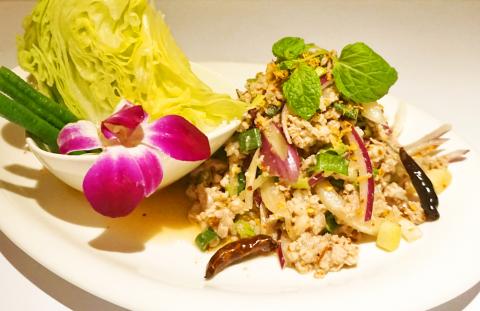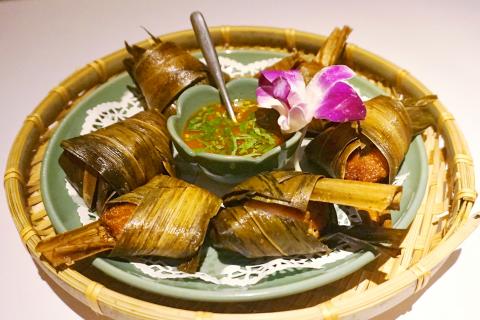My gastronomical adventures around the world have taught me two things: The concept of “fusion” is ridiculous (you’ll never find “General Tso’s chicken” in China) and it is almost impossible to go wrong with Thai food.
For whatever reason, the Thai restaurants of the world seem to hold themselves accountable to a higher standard, relying on authentic flavors and cooking styles to win over clientele rather than coming up with bizarre hybrid concoctions that they think will suit the local palate more. The same holds true for Taiwan. While I have had some disappointing experiences with restaurants claiming to be “Malaysian” or “Vietnamese,” Taiwan’s Thai restaurants always make the cut.
Home’s Thai Cuisine’s latest branch on Taipei’s Guangfu South Road (光復南路) is, unequivocally, one of the best Thai restaurants I’ve tried outside of Thailand. The breezy, one-story establishment, lined with potted plants on the outside, is located in an alley near Sun Yat-sen Memorial Hall that is filled with restaurants serving various types of cuisines from paella to donburi. Also nearby is a gourmet chocolate shop, a florist and a shop selling hair dyes.

Photo: Dana Ter, Taipei Times
The interior is a mixture of jade green and dark wood walls decked with black and gold paintings. The seats are dark leather while colorful silk pillows line the sofas. The waiter immediately rushed to our table to poured us cups of complimentary warm lemongrass tea and handed us our menus. Give yourself more than a couple of minutes to study the menu though because it is exhaustive. In the meantime, I knew the food would not disappoint, as the tea was quite exquisite — herbal, gingery and zesty.
We decided to stray from the usual Pad Thai, and order a variety of meat and vegetable dishes. If you can handle spicy, try the traditional Thai minced meat with lettuce (NT$300). Although technically an appetizer, it is hefty enough for a full meal. The minced pork is tender and interlaced with an alluring herbal spiciness that emanates from the spring onions and chili peppers that it is cooked with. The onions add a crunchy dimension, while the lettuce you wrap the meat in makes it cool and refreshing. The minced pork also pairs well with some steamed rice.
Next up is the chicken wrapped in pandan leaf (NT$350). This classic Thai appetizer, which looks fairly simple to make, in fact requires a lot of preparation, and Home’s does an exceedingly good job at achieving the appropriate sweet-savory balance in the garlic, coriander and chili paste that the meat simmers in. The chicken is very tender with the pandan leaf giving it an aromatic kick. It also boasts a mild floral fragrance with milky, coconut undertones. The chili parsley dip is a nice touch, adding to the sweet-savory balance.

Photo: Dana Ter, Taipei Times
The spicy fried cabbage with shrimp paste (NT$190) is not for the faint of heart. The dish is incredibly spicy, though in a delightful, savory way. The cabbage is crunchy with the mushrooms providing a softer dimension, though it is the shrimp paste that is the show stealer. Salty, pungent and possessing an aroma akin to roasted shrimp, it helps draw out the texture of the cabbage.
Another must-try is the green curry with beef (NT$370). I have had my share of Thai green curries, but here it is done in a way that is delicate and hearty at the same time. The beef is chewy, thinly sliced and simmering in a thick, creamy curry which boasts an appealing mixture of coconut milk and fish sauce. The dish is pungent but not too spicy, and leaves you with a delightful coriander-lemongrass aftertaste. The curry also makes a good dip for the small slices of toast it is served with.
Herbal, pungent and flavorful, Home’s is the real deal when it comes to Thai cuisine. There is no holding back on the chili peppers, lemongrass and coriander here, and simple as it may seem, it goes to show that the best recipe for success is, ultimately, keeping the flavors authentic.

Photo: Dana Ter, Taipei Times

The Taipei Times last week reported that the rising share of seniors in the population is reshaping the nation’s housing markets. According to data from the Ministry of the Interior, about 850,000 residences were occupied by elderly people in the first quarter, including 655,000 that housed only one resident. H&B Realty chief researcher Jessica Hsu (徐佳馨), quoted in the article, said that there is rising demand for elderly-friendly housing, including units with elevators, barrier-free layouts and proximity to healthcare services. Hsu and others cited in the article highlighted the changing family residential dynamics, as children no longer live with parents,

Oct 20 to Oct 26 After a day of fighting, the Japanese Army’s Second Division was resting when a curious delegation of two Scotsmen and 19 Taiwanese approached their camp. It was Oct. 20, 1895, and the troops had reached Taiye Village (太爺庄) in today’s Hunei District (湖內), Kaohsiung, just 10km away from their final target of Tainan. Led by Presbyterian missionaries Thomas Barclay and Duncan Ferguson, the group informed the Japanese that resistance leader Liu Yung-fu (劉永福) had fled to China the previous night, leaving his Black Flag Army fighters behind and the city in chaos. On behalf of the

I was 10 when I read an article in the local paper about the Air Guitar World Championships, which take place every year in my home town of Oulu, Finland. My parents had helped out at the very first contest back in 1996 — my mum gave out fliers, my dad sorted the music. Since then, national championships have been held all across the world, with the winners assembling in Oulu every summer. At the time, I asked my parents if I could compete. At first they were hesitant; the event was in a bar, and there would be a lot

Smart speakers are a great parenting crutch, whether it be for setting a timer (kids seem to be weirdly obedient to them) or asking Alexa for homework help when the kids put you on the spot. But reader Katie Matthews has hacked the parenting matrix. “I used to have to nag repeatedly to get the kids out of the house,” she says. “Now our Google speaker announces a five-minute warning before we need to leave. They know they have to do their last bits of faffing when they hear that warning. Then the speaker announces, ‘Shoes on, let’s go!’ when